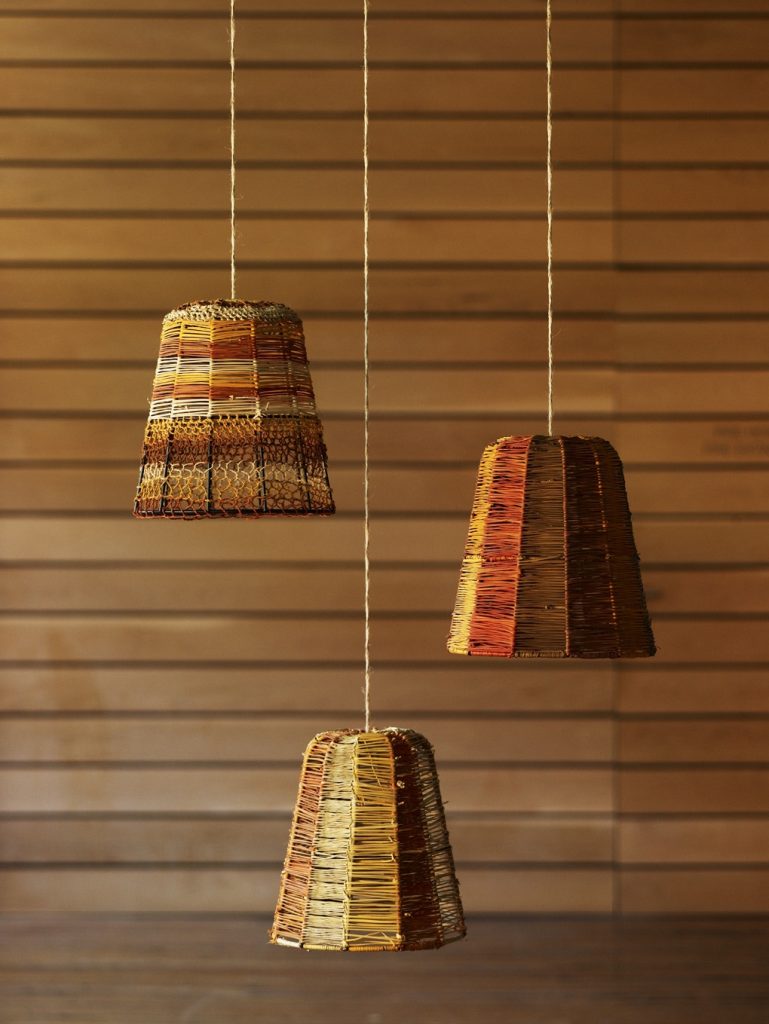Elcho Island (Galiwin’ku) artists, Mapuru, and Koskela:Yuta Badayala (In A New Light).

Yuta Badayala (In A New Light) is a collaborative project between Indigenous weavers from the Galiwin’ku Elcho Island community and Mapuru and Koskela, an Australian design company. This case study looks at the processes involved in establishing a collaborative project, the protocols and the possible agreements to put in place.
Background
In 2007 Sasha Titchkosky, a director of Koskela, came across the weaving from Elcho Island on the internet by chance. Sasha was interested in finding a way to combine the traditional weaving with a contemporary design aesthetic. After contacting ANKAAA, being directed to, and having an initial conversation with Elcho Island Art Centre Sasha attended the Selling Yarnsconferences in Darwin and Canberra to find out more about the craft and how it might apply to contemporary products. At Selling Yarns Sasha met women from Mapuru doing weaving and started to think about lighting, a product that people were prepared to pay more money for, which was important given how much work went into the weavings.
Sasha then attended the Darwin Art Fair and on the off chance took 2 lampshade frames with her. There she met artist, Mavis Ganambarr and the then Elcho Island Art Centre manager, Dion Teasdale. Mavis embraced the project and subsequently Sasha visited Elcho Island a couple of times to get a better understanding of the lives of the women weavers and how they work. The Elcho Island women have also visited Koskela in Sydney. This has helped developed the trust between them and has deepened the company’s involvement with the product. Sasha believes the women have enjoyed sharing their culture with Koskela and it has certainly helped selling the lights given the strength of the cultural context.
For Koskela, the aim of the project was to create a long term sustainable business opportunity for the women. Interestingly, the interior design community is always looking for something new and as the women are always interpreting the forms in new ways, in turn their new ideas excite the design community.
Processes, Protocols and Agreements
Throughout the process the involvement of the Elcho Island Art Centre has been integral to success of the project. Having the support of both the art centre manager and Mavis Ganambarr and Judy Manany who are both artists and are also employed at the art centre, has also been critical to achieving good outcomes. The art centre administers the project and Mavis and Judy ensure that the light frames are fairly distributed to the women weavers (and they also nag them to finish them if there are delays).
At the beginning of the project Koskela decided it was important was to work through the art centre rather than with artists on an individual basis. This means that pricing is agreed through the art centre and artists are paid a fair rate of pay. Koskela are very conscious of the exploitation that has gone in the Indigenous art industry and wanted to avoid any taint of the problems that have been associated with some in the Indigenous art trade. The pricing was not difficult to determine as it has similarities with payment systems that were already in place. The artists are paid according to both the size of the lampshade and the quality of the weaving. The art centre manager decides the payment and if there are any disputes Mavis Ganambarr and Judy Manany arbitrate. The arrangement makes for certainty for Koskela and the artists. The art centre also gets a management fee for all the work it does managing the project.
Koskela and the art centre have a memorandum of understanding in place with commitments about how many shipments they will be managing each year (about 4) and the women have a reasonable idea about the income stream from the lights project throughout the year.
Indigenous Intellectual Property issues
Early on Sasha realised the women wouldn’t be interested in replication so whilst there are some very basic parameters, for example, don’t cover the hole for the light fitting, the women are free to interpret the form as they like, with the women coming up with new interpretations of traditional designs all the time. At one stage they looked at adapting the project to chairs and the women experimented with collecting stronger grasses from the northern part of the island and reviving weaving with this fibre but in the end found it was too difficult to work with.
Koskela attributes every artist with the artist’s name as well as the art centre being attached to each of the lampshades. Every lampshade has a serial number and is catalogued and the purchaser also gets a biography of the artist. In terms of the copyright, the form belongs to Koskela and the weaving to the artist, so it is a truly collaborative effort. Koskela and Elcho Island Art Centre are looking at how to address this and the management of the IP in the development of a new agreement so it is clear who can give permissions for reproductions in the future.
https://www.artslaw.com.au/images/uploads/Koskela_Elcho_050110-016_3.jpg
Further resources you might find useful:
– AITB copyright information sheet and comic
– AITB moral rights information sheet and comic
– AITB ICIP information sheet and comic
– Art centre gallery agreement
More about this project and the organisations:
Elcho Island Art Centre www.elchoarts.com; http://www.marthakal.org/page/elcho-island-arts.aspx